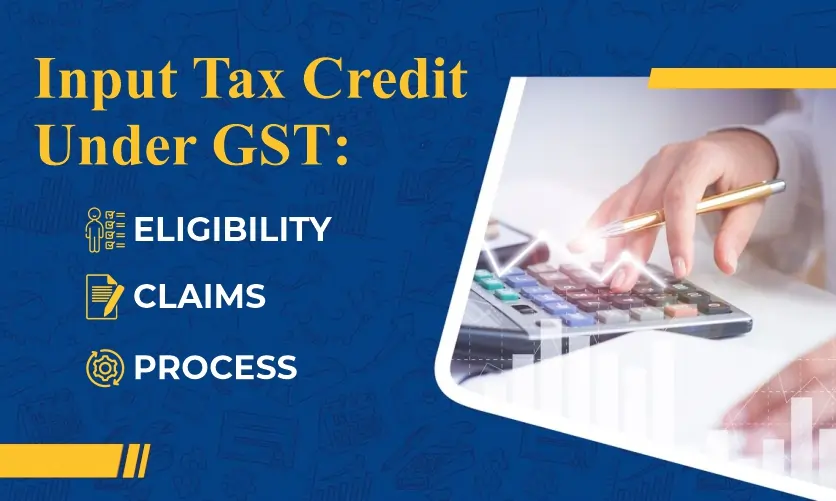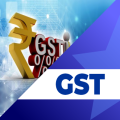
Input Tax Credit under GST: Eligibility, Claims and Process
The introduction of Goods and Services Tax (GST) in India brings major changes in the tax system with its multiple features. One of the most important features is input tax credit under GST.
Input Tax Credit in GST reduces the “tax on tax” problem and makes the complete tax system more transparent and efficient. This guide explains what the Input Tax Credit under GST means, who can claim it, how to calculate it, and how it benefits businesses.
Before diving into its complexities, let’s first understand its basics.
Table of Contents
Understanding Input Tax Credit Under GST Regime
The Input Tax Credit under GST allows businesses to deduct the tax they have already paid on their purchases from the tax they owe on their sales. It means businesses are only taxed on the value they add, not the entire value of the goods or services they provide. This system eliminates the “tax on tax” problem, making it fairer and more efficient for businesses.
What is an example of ITC?
Scenario: A Furniture Manufacturer
Purchase of Raw Materials:
- Let us consider the manufacturer purchased the raw material at the cost of Rs 1,00,000.
- GST rate applied on raw materials: 18%
- Total GST that manufacturer pays on raw materials = ₹1,00,000 * (18/100) = ₹18,000
Manufacturing Process:
The manufacturer uses these raw materials to produce furniture.
Sale of Furniture:
Now the manufacturer sells the finished product to retailers.
The selling price of furniture: ₹2,00,000
GST rate applied on the sale of furniture: 18%
GST collected on the sale = ₹2,00,000 * (18/100) = ₹36,000
Calculation of Input Tax Credit (ITC):
Let’s see how ITC is calculated in this case. The manufacturer can apply for ITC on the furniture’s raw materials.
Input Tax Credit (ITC) = GST paid on raw materials = ₹18,000
Net Tax Liability:
The net tax liability is calculated by reducing the Input Tax Credit from the GST collected on furniture sale.
Net Tax Liability = GST collected on sale – Input Tax Credit
Net Tax Liability = ₹36,000 – ₹18,000 = ₹18,000
In this example, the Input Tax Credit of ₹18,000 can be offset against the GST liability on the sale of furniture. It means that the manufacturer can deduct the tax paid on raw materials from the tax collected on the sale, resulting in a net tax liability of ₹18,000.
Check out the recent updates on the Input Tax Credit here
Eligibility Checklist: Claiming Input Tax Credit under GST
Possession of Tax Invoice
If you have a proper invoice ,then you can claim input tax credit under GST. Make sure the invoice consists of the following details:
- The supplier’s GST number
- A unique number
- The date it was issued, and
- A detailed description of what you bought.
Goods and Services Used for Business
Make sure to claim an input tax credit for only those products that are used in the business process. If you claim ITC for any personal belongings unrelated to your business , then it is not considered.
Registered under GST
To get the benefits of input tax credit businesses should register under GST. It means businesses that still not registered or are on a special plan (composition scheme) can’t use it.
Goods and Services Should be Taxable
Businesses can only receive input tax credits only on those products that are taxable under GST. One can not get any claim for things that do not come under the GST regime.
Timely Filing of GST Returns
Ensures that you file your GST returns on time to avail the benefits of Input tax credit in GST. If you delay your filing or forgot to file , then you may lose the credit you’re owed.
Documents Based on Which the ITC Can Be Claimed
- Tax Invoice
To claim an input tax credit under GST, you must have a tax invoice that you get from your supplier. The invoice must contain all the necessary information and should follow the official format. - Debit Note
If your supplier changes the invoice amount ,or you owe more tax, you can claim the input tax credit based on a debit note they issue. - Bill of Entry
When goods are imported ,the Bill of Entry is considered to be the most important document for claiming input tax credit in GST. This document contains details like your name, a description of the goods, and their value. - Invoice or Debit Note from Input Service Distributor (ISD)
If your business receives services from an Input Service Distributor (ISD), you can claim the input tax credit based on the document they issue, which could be either an invoice or a debit note.
It’s a great idea to learn new things to improve knowledge and skills. Check out these related articles on GST here to read:
Hope you understand the basics of input tax credit in GST. In the next section, we will dive into more detailed concepts of the claiming process of input tax credit under GST.
How to Claim Input Tax Credit?
Following is the step-by-step process for claiming the Input tax credit in GST:
- Maintain Proper Records
Make sure that all the document like invoices, debit notes, and other important documents is managed properly for claiming the input tax credit. To manage this task , you can take the help of technology or can also use record-keeping systems to stay compliant. - File GST Returns Timely
Never miss the deadline! for filing your GST returns. Always apply GST return on time to claim the input tax credit without any delays or problems.
Attention taxpayers! November 30th is the final deadline for claiming input tax credit for the 2022-23 financial year and fixing any discrepancies in your GST filings. - Reconcile Invoices
Check your invoices to avoid any mistakes. Try to compare it with the information on the GST portal regularly. This helps you catch and fix any mistakes quickly. - Comply with Anti-Profiteering Regulations
To avoid penalties, businesses must follow the rules against raising prices excessively. This means they must pass on the savings from lower taxes to their customers, which is required to claim the input tax credit.
Step into the ITC Zone: Understanding Your Eligibility under GST
Provision of Goods or Services
Businesses when involved in the supply of goods or services can claim an input tax credit (ITC). This credit belongs to the taxes paid on inputs, capital goods, and input services that the business has used for its operations.
Receipt of Goods or Services
The other scenario is when a business receives the goods or services. In this case, also ,they can claim an input tax credit under GST. This credit is associated with the taxes they pay on these inputs to move goods.
Fulfillment of Conditions
There are a few basic conditions needed to apply for an input tax credit ,like having a valid tax invoice and using the purchased goods or services for business activities.
Interested in learning a few more insightful articles on GST , then visit here:
In the previous section, we discussed who can claim an input tax credit in GST. Now we will explain who is not allowed to claim input tax credit
When Does One Become Ineligible to Claim Input Tax Credit under GST?
Non-Compliance with Conditions
If you have not kept the important documents that are required for claiming ITC , or you have used the purchased goods for personal use. In both cases, you can not apply for the input tax credit in GST.
Purchase of Exempted Goods or Services
If the selected goods do not come under the GST regime, then you can’t claim the input tax credit (ITC) for the taxes you paid on those purchases.
Non-Filing of Returns
Sometimes businesses do not claim the ITC on time or forget to claim in both conditions ,they will lose the opportunity to get the ITC.
If you want to learn the GST from experts ,then explore the courses here and become an industry expert:

Looking for the recent updates on GST ,Check out here
Latest updates on GST
Time Limits for Claiming Input Tax Credit
- Claiming in the Same Financial Year: Businesses can apply for the input tax credit (ITC) for a financial year either in their September GST return for the following year or in their annual return, whichever they file first.
- Unclaimed ITC from the Previous Financial Year: If you have any leftover input tax credit (ITC) from the previous financial year, you can claim it in your September GST return or your annual return, whichever you file first. But remember, you can only claim it if your suppliers have uploaded the necessary invoices or debit notes.
- Final Opportunity for Previous Financial Year: Businesses have one last chance to claim any unused input tax credit (ITC) from the previous financial year. They can do this in their March GST return for the next financial year.
List of Products/Services Exempted From ITC
| Category | Items |
|---|---|
| Food & Beverages | Alcoholic beverages (except by licensed manufacturers/traders) – Food & beverages for on-site consumption – Outdoor catering services – Tobacco & related products – Ice cream & edible ice (except factory-packed) – Sweetmeat & confectionery (except factory-packed) – Non-alcoholic beverages (except sealed containers) |
| Conveyance & Transportation | Passenger transportation (except air, rail, water) – Goods transport (except air, rail, water) – Motor vehicles (except specific uses like goods transport, passenger services, driving schools etc.) – Rent-a-cab services – Inland waterways transport services |
| Hospitality | Accommodation (except hotels, motels, guest houses with tariff exceeding Rs. 1,000/day) – Rent-a-car services |
| Services | Lottery, betting, gambling, casino services – Horse racing services – Services by clubs & associations (except notified by Govt.) – Goods & services to SEZ units – Life & health insurance – Stockbrokerage services – Land sale (except consideration below Rs. 50 lakhs) – Club/association membership services – Warehouse/commercial space rental services – Air, rail, water transport services (except by construction, mining, oil exploration businesses) – Sub-contractor services to main contractor – Employee services provided by employer – Services by way of agricultural product sale (except under supply contracts) |
| Other | Goods forfeited under law – Destroyed/lost goods – Goods disposed of as gifts/free samples |
Calculating Input Tax Credit
Direct ITC and Blocked Credits
Businesses can claim direct ITC on those goods and services that are used directly in their products or business services. However, there are a few items like buying motor vehicles and other specified items that are restricted or unavailable for input tax credit claim.
ITC on Capital Goods
Businesses can get a tax credit (ITC) for capital goods like machinery and equipment over time. They can claim the credit in installments, spreading the benefit over the lifespan of these important assets.
Reverse Charge Mechanism (RCM)
If the business works under a reverse charge mechanism then they have to pay tax to the government on goods or services received instead of the supplier. While this changes who pays the tax, the recipient can still claim the input tax credit (ITC) for the tax they paid.
Transitional Credit
One more option that businesses can choose is the transitional credit which offers businesses a chance to transfer the credit for taxes paid under the old tax system (before GST) to the new GST system. Thus, it makes the whole process easy for businesses to adjust to the new system during its early stages.
Read some more articles on GST here:
Impact of ITC on Businesses
Input tax credit under GST brings a lot of changes in the business ecosystem. Let’s check out how it impacted Indian businesses:
Cost Efficiency
The current tax system removes the burden of paying double taxes. Now ,businesses don’t need to pay tax on the full price of their products or services. It helps businesses to get more profit and improve their overall effectiveness.
Competitiveness
Businesses now started claiming input tax credits ,which reduces the total tax bill for them and makes them more competitive. This system especially helps those industries where material costs and supplies cover a large part of the final product or service price.
Encouragement for Compliance
If businesses want smooth business operations ,then they must follow the tax rules and GST system. It also gives them the benefits of claiming ITC by filing returns on time.
Simplification of Tax Structure
The GST regime offers a clear ,transparent tax system for both the government that receives the taxes and the businesses that pays it. Businesses now easily get back the return taxes that they paid on materials and supplies, and authorities can easily track all these systems. Thus, it reduces the chances of conflicts between the government and businesses.
Conclusion
The Input Tax Credit in GST brings significant changes to the tax system to streamline the complete process and reduce tax burdens on businesses. To use the benefits of input tax credit in GST, businesses need to follow the GST rules and meet relevant conditions, and eligibility criteria.
As the GST framework continuously evolves from time to time ,businesses need to stay updated with regulatory changes and technological advancements to navigate the complexity of Input Tax Credits effectively.
With the clear goal of making the tax system simplified ,GST system helps businesses a lot. Businesses not only claim ITC but also contribute to a larger vision of a simplified and robust tax structure.
If you need more information on input tax credit in GST ,then visit here:
Input tax credit updates
- 50 Important Rectification Of Errors Questions For Interview - January 5, 2026
- 50 Important Cash Book Questions & Answers For Interview Preparation - January 5, 2026
- Job Oriented Courses For Commerce Graduates: Essential Things To Know - December 26, 2025

.jpg)






















